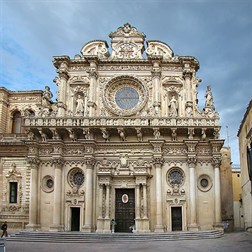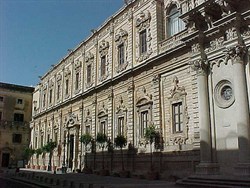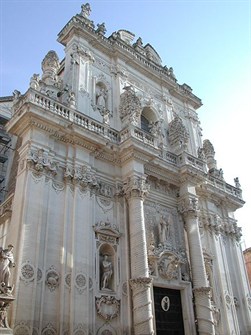Giuseppe Zimbalo: Basilica of Santa Croce, Palazzo dei Celestini, Church of the Rosario
The architect and sculptor Giuseppe Zimbalo (1620-1710) is widely considered the greatest exponent of the Baroque in Lecce. The grandson of Francesco Antonio Zimbalo, another famous architect in the history of Lecce, Giuseppe Zimbalo is also known as the Zingarello, an Italian translation of the word in dialect Zimbarieddu or, literally, “little Zimbalo”, to distinguish him from his father and grandfather, both dedicated to the same art.
 The third and most famous member of the Zimbalo family produced some of the most important buildings of Lecce. In addition to the reconstruction of the Cathedral, the design of the bell tower and the raising of the Column of Sant’Oronzo, Zimbalo also contributed to the building, which was conducted over many centuries, of the Basilica of Santa Croce, which, along with the former CelestineThe Celestines were originally called the Brothers of the Holy Spirit or majellesi (from the monastery of Santo Spirito at Majella) and then the Morronites (for Morrone’s monastery), were the monks belonging to the Congregation founded by Peter of Morrone in the thirteenth century. They assumed the name of Celestines after the pontificate and canonization of Peter of Morrone (Pope Celestine V), and spread in the following centuries even outside of Italy. The monasteries of the Order were all suppressed between the eighteenth and nineteenth century. convent, now seat of the Province of Lecce, constitutes one of the major architectural complexes in the city. The project was started in 1549 on land obtained from the confiscations from the Jewish community expelled from the city in 1510. The first phase of work, which lasted until 1582, led to the construction of the lower area of the façade, up to the balcony, and was directed by the architect Gabriele Riccardi. The second phase, in 1606, met with the contribution of Zimbalo’s grandfather, Francesco Anthonio, who added the three decorated portals. The third and last phase of the work were undertaken by Zingarello with Cesare PennaCesare Penna (1607-1680) was a sculptor from Lecce, a protagonist of the great Baroque period experienced by the city in the seventeenth century. His most famous works can be seen in the Basilica of Santa Croce and in the Church of Santa Teresa, both built by architect Giuseppe Zimbalo. Outside of Lecce Penna was also active in other centers of Apulia, such as Maglie and Martina Franca., another illustrious exponent of the Baroque in Lecce: their mastery provided the upper part of the façade, the rose window and the gable on the top of the structure. The date 1646 is carved near the rose window.
The third and most famous member of the Zimbalo family produced some of the most important buildings of Lecce. In addition to the reconstruction of the Cathedral, the design of the bell tower and the raising of the Column of Sant’Oronzo, Zimbalo also contributed to the building, which was conducted over many centuries, of the Basilica of Santa Croce, which, along with the former CelestineThe Celestines were originally called the Brothers of the Holy Spirit or majellesi (from the monastery of Santo Spirito at Majella) and then the Morronites (for Morrone’s monastery), were the monks belonging to the Congregation founded by Peter of Morrone in the thirteenth century. They assumed the name of Celestines after the pontificate and canonization of Peter of Morrone (Pope Celestine V), and spread in the following centuries even outside of Italy. The monasteries of the Order were all suppressed between the eighteenth and nineteenth century. convent, now seat of the Province of Lecce, constitutes one of the major architectural complexes in the city. The project was started in 1549 on land obtained from the confiscations from the Jewish community expelled from the city in 1510. The first phase of work, which lasted until 1582, led to the construction of the lower area of the façade, up to the balcony, and was directed by the architect Gabriele Riccardi. The second phase, in 1606, met with the contribution of Zimbalo’s grandfather, Francesco Anthonio, who added the three decorated portals. The third and last phase of the work were undertaken by Zingarello with Cesare PennaCesare Penna (1607-1680) was a sculptor from Lecce, a protagonist of the great Baroque period experienced by the city in the seventeenth century. His most famous works can be seen in the Basilica of Santa Croce and in the Church of Santa Teresa, both built by architect Giuseppe Zimbalo. Outside of Lecce Penna was also active in other centers of Apulia, such as Maglie and Martina Franca., another illustrious exponent of the Baroque in Lecce: their mastery provided the upper part of the façade, the rose window and the gable on the top of the structure. The date 1646 is carved near the rose window.
 As far as the Palazzo dei Celestini, it also was built in 1549, based on a project by Riccardi, but most of the work was carried out during the next century under the direction of Giuseppe Zimbalo, who worked on the first level of the long main façade. The second level was instead completed by Giuseppe Cino, another exponent of the Barocco leccese and a student of Zimbalo.
As far as the Palazzo dei Celestini, it also was built in 1549, based on a project by Riccardi, but most of the work was carried out during the next century under the direction of Giuseppe Zimbalo, who worked on the first level of the long main façade. The second level was instead completed by Giuseppe Cino, another exponent of the Barocco leccese and a student of Zimbalo.
 The construction of the Church of San Giovanni Battista (Saint John the Baptist), or del Rosario, was instead entrusted by the Dominicans to Zimbalo when he was already over seventy years old. The aged architect, who devoted himself to the work from 1691 until his death in 1710, contributed personally to the financing of the work. Still incomplete at the death of its creator, the structure was completed in 1728 by some local artists, and Zimbalo had asked to be buried in it.
The construction of the Church of San Giovanni Battista (Saint John the Baptist), or del Rosario, was instead entrusted by the Dominicans to Zimbalo when he was already over seventy years old. The aged architect, who devoted himself to the work from 1691 until his death in 1710, contributed personally to the financing of the work. Still incomplete at the death of its creator, the structure was completed in 1728 by some local artists, and Zimbalo had asked to be buried in it.
